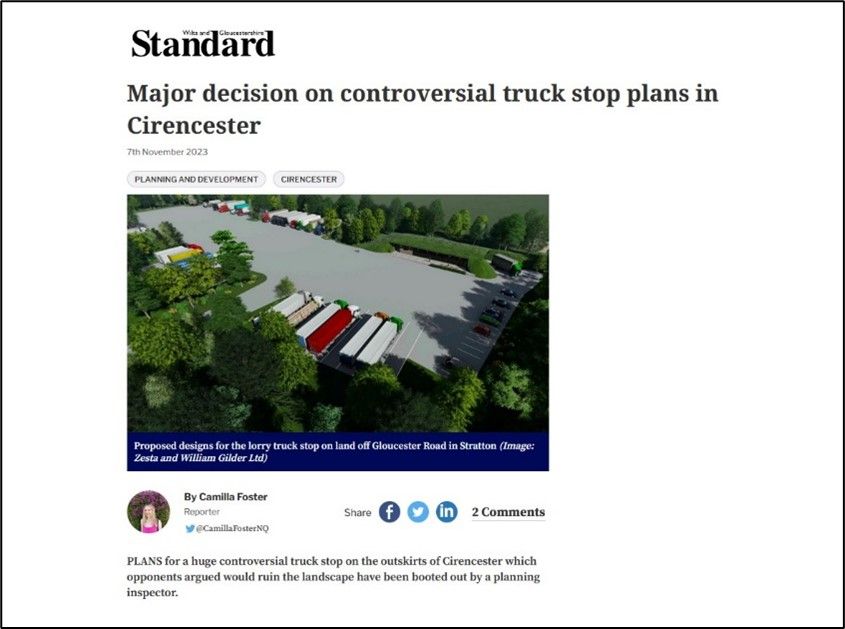
Lorry Parking: Location of HGV and Parking Facilities in the Cotswolds
- By Michael Hatfield
- •
- 24 Jan, 2024
While there is an urgent need to provide additional parking facilities for both HGV and LGV drivers, new sites should be appropriately located so that they can best serve the operational requirements of the sector, but also conform with planning policy and minimise their environmental impacts. This has now been confirmed by a recent planning decision relating to a proposed lorry park in the Cotswolds.

The need to provide additional and better quality parking facilities for freight vehicle drivers is recognised by both the public sector and the logistics industry. The National Survey of Lorry Parking, initially undertaken for the DfT in 2017 and re-freshed in 2022, identified a shortage of suitable facilities for HGVs across England, causing significant levels of parking at inappropriate locations which lack driver amenities, such as industrial estate roads. Planning policy has recently been updated alongside the provision of match-funding to support investment from the private sector in new facilities. A revised DfT Circular published in 2022 set out the Government’s updated policy, including providing guidance on the maximum distances between HGV parking facilities. The main industry trade bodies, the Road Haulage Association and Logistics UK, have run campaigns to raise awareness of this issue.
Despite this urgent need, it is important that proposed sites for new parking facilities are appropriately located so that they can best serve the operational requirements of the logistics sector, but are also sited where environmental impacts are minimised, such as away from residential areas or ecologically sensitive locations. Freight vehicle parking facilities are required for three operational reasons:
- Where drivers can take legally required break and rest periods – as stipulated in the EU drivers’ hours rules;
- While waiting to undertake deliveries/collections at depots or distribution centres – HGVs are often allocated a narrow time-slot during which any deliveries/collections must be undertaken, with drivers consequently needing to wait close-by ahead of allotted times; and
- Provide access to driver amenities during break and rest periods – such as toilets, washing facilities, and food and drink refreshments.
In terms of satisfying these operational requirements, it follows that an appropriately sited freight vehicle parking facility should be located a short distance from the strategic highway network (motorway or long-distance dual-carriageway) AND also adjacent to major freight depots or distribution centres. Such a facility would be able cater for all three parking requirements simultaneously; it could intercept ‘passing trade’ on the strategic highway network (breaks and rest needs) and provide parking ahead of allotted time-windows at nearby freight generators. Driver throughput would be maximised, which is important as HGV parking facilities are operated on a commercial basis. In land-use planning terms, it is also a more efficient use of land as only one site needs to be developed. This position is reflected in the current National Planning Policy Framework (NPPF).
However, parking facilities will need 24/7 access for HGVs, with lighting required to provide a safe operating environment during hours of darkness. They also generate significant noise and visual intrusion, with ecological impacts also needing to be accounted for. For this reason, appropriate sites will also need to be away from incompatible land uses (e.g. residential), where the highway access can support round-the-clock HGV movements in large numbers and where the noise and visual impacts do not conflict with the wider spatial setting.
During 2023 MDS Transmodal provided advice to Cotswold District Council on the potential development of a new overnight HGV park near Cirencester. The proposed facility was located adjacent to the A417 dual-carriageway, and was planned to provide parking for 75 HGVs with toilet, washing and refreshment facilities. It could have provided parking for drivers undertaking breaks and overnight rest periods.
However, the site is located within the Cotswold Area of Outstanding Natural Beauty (AONB). The NPPF currently states that consent should be refused for major development in AONBs other than in exceptional circumstances (particularly where the need can be met at locations outside the AONB). In addition, there would have been significant visual and noise impacts within the wider rural setting. For those reasons, Cotswold District Council refused planning consent for the development. The promoter subsequently appealed to the Planning Inspectorate (PINS), with the case tested at a Public Inquiry held in February and May 2023.
MDS Transmodal presented expert witness evidence at the inquiry on behalf of the Council. In particular, the three operational reasons for HGV parking facilities set out above were explained, and by implication the types of sites which can therefore be considered appropriate for accommodating such facilities were described i.e. near the strategic road network and distribution depots. While acknowledging the urgent need to provide additional HGV parking facilities, MDST demonstrated by means of an alternative sites assessment that there are other sites close-by but outside the AONB better able to meet all three operational requirements simultaneously, thereby conforming with the NPPF.

In November 2023, PINs dismissed the appeal and refused consent. The Planning Inspector’s reasoning for dismissing the appeal specifically mentions MDS Transmodal’s evidence presented at the Inquiry, in particular that the proposed site would not provide parking near warehousing activity. The full Decision Statement from PINs can be downloaded here.
